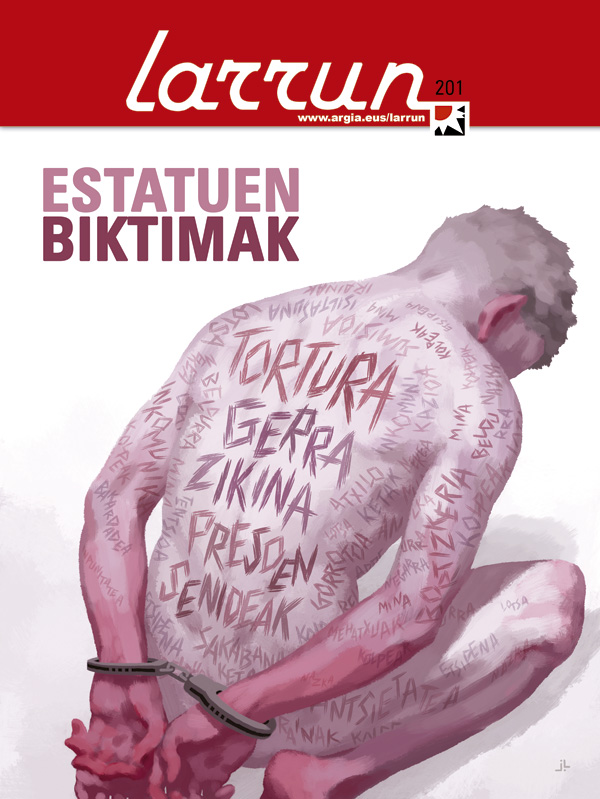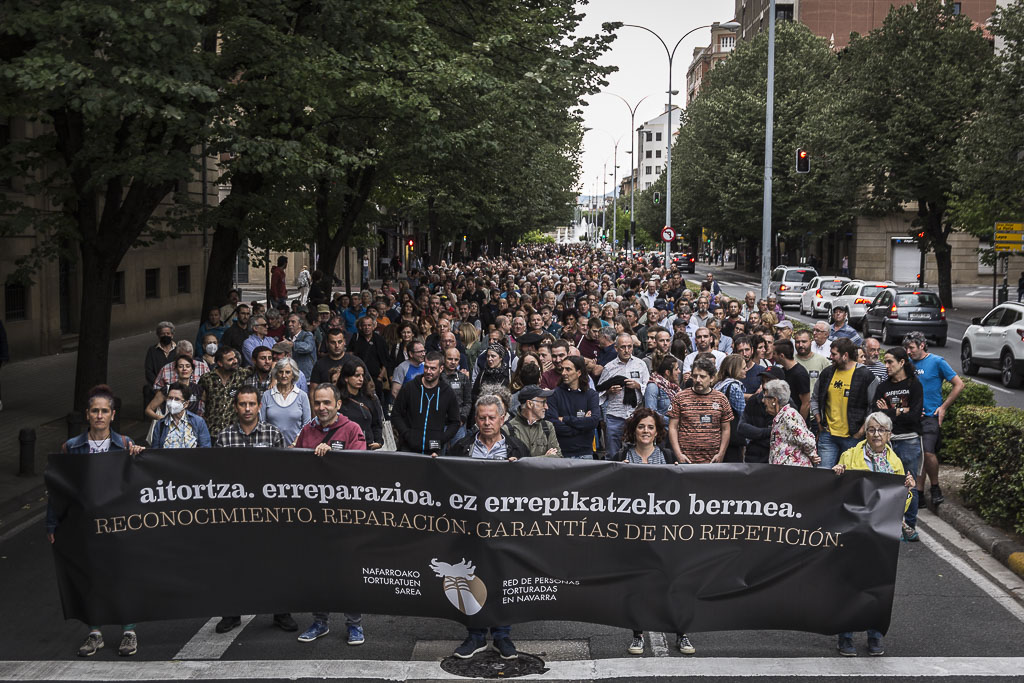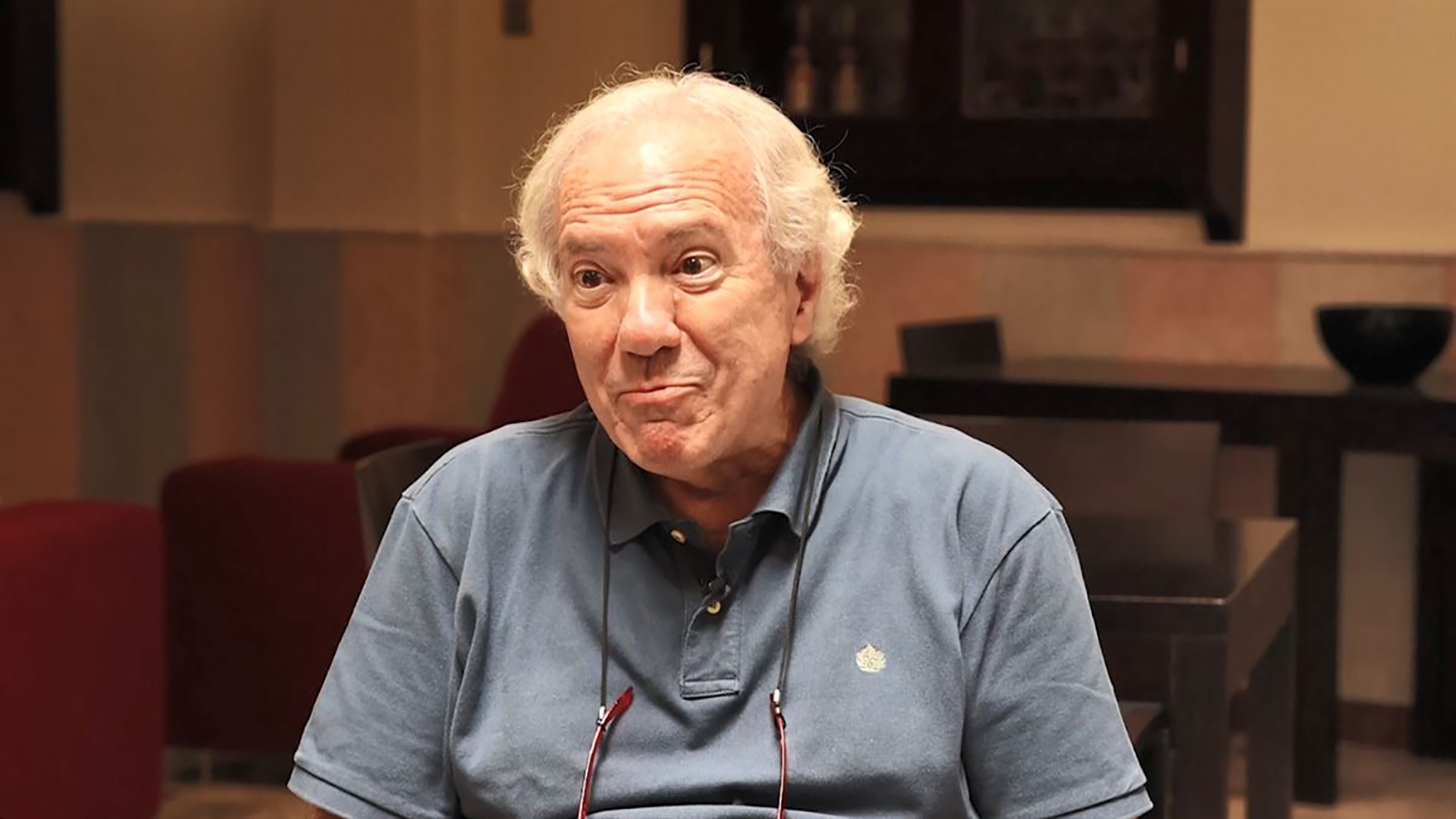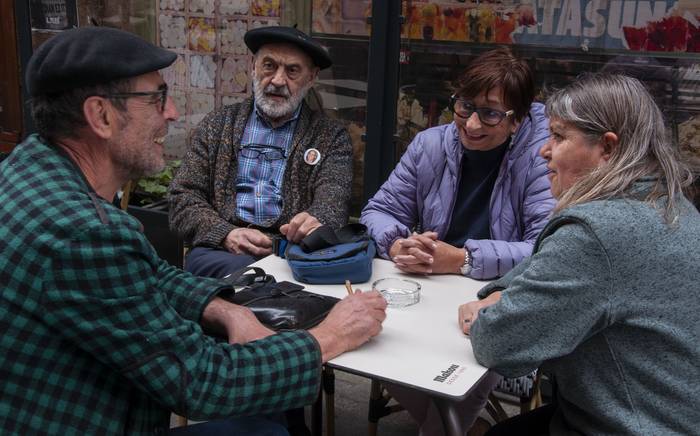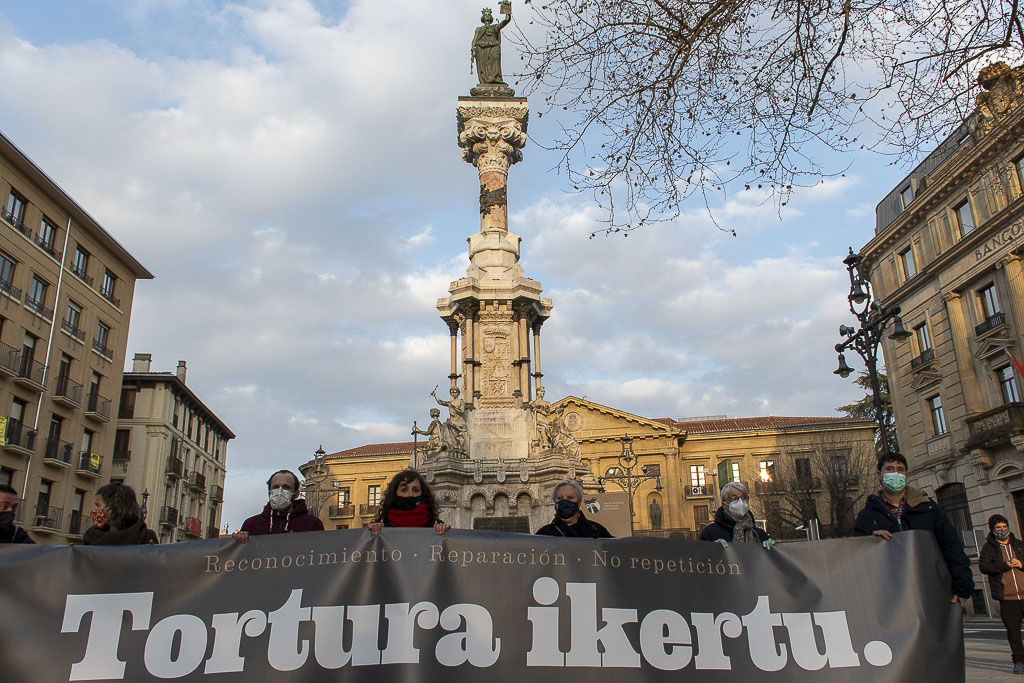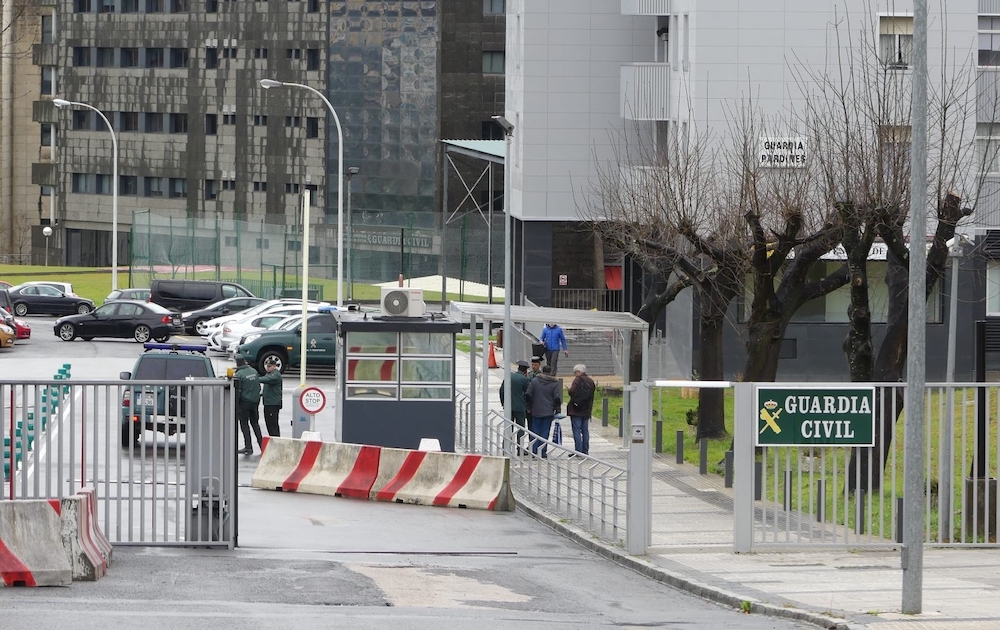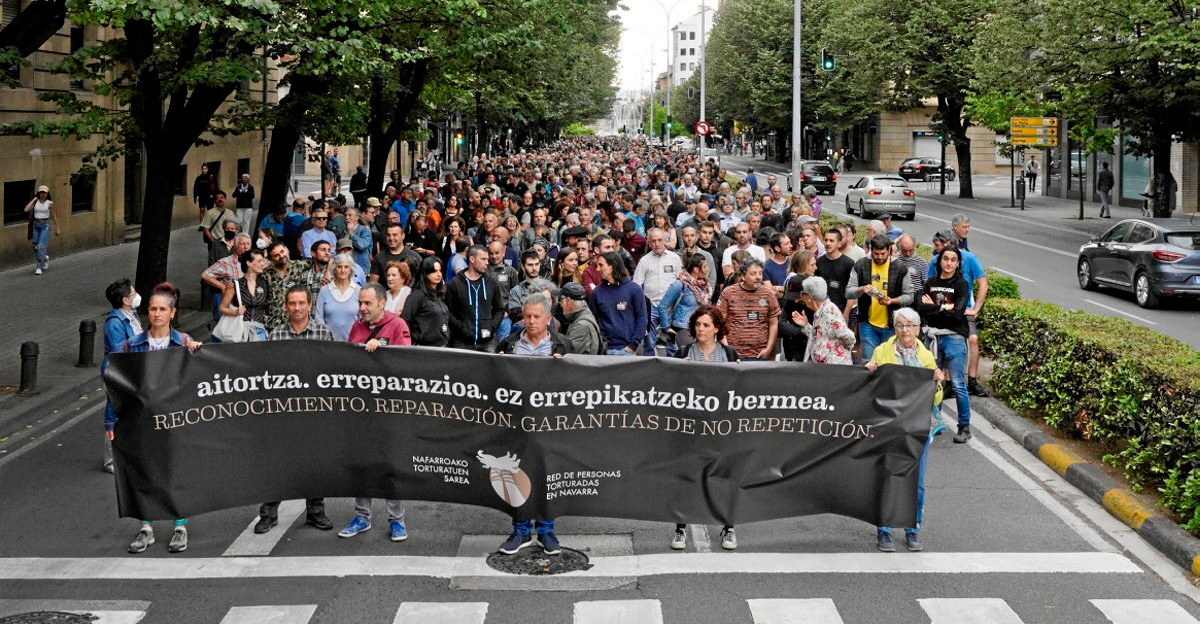"Torture takes forever."
- Oihana Barrios (Pamplona, 1982) is a young woman who is in a small group that knows a lot about torture in the Spanish state. Jaiki Hadi is a psychologist of the association who takes care of people who have suffered political violence in the Basque Country. He is also a member of the Human Rights Directorate of the Spanish Association of Neuropsychiatry. And professor of the Istanbul Protocol, which is considered a fundamental instrument for demonstrating torture. We have thrown into the darkness of torture with their explanatory work and, above all, we have immersed ourselves in their influence on people.
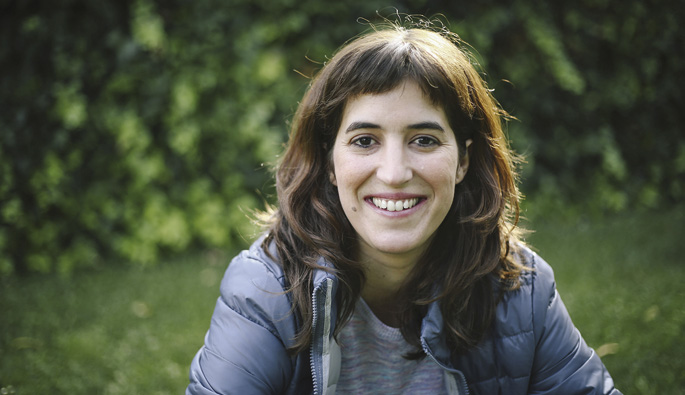
In Euskal Herria, torture has gone down in numbers in the last four years. There are far fewer arrests, but the State also has increased international pressure each year. There have also been changes in the forms, “especially psychological, not physical”, explains Barrios. Those who send in Spain do not like the work of the psychologist, who was arrested in the operation against Jaiki Hadi last March. He is now processed, he is also a victim of “ETA”.
What is the torturer looking for?
It may be that in the 70s or 80s it is a technique of seeking information, but in the last decade it is clear that the information they want already has it before being tortured. After many years of study on the subject of torture, I do not believe that this is the most important objective. It is used more to destroy a political movement than for that. Every individual is destroyed to scare and destroy an entire collective.
What is the torturer like? Can you do research to find out what kind of people they are?
It's hard because they're not willing to talk to the researchers. In very few cases, interviews have been conducted with torturers, particularly from Latin America and Eastern Europe. They are often repentant torturers who cannot live peacefully. But most torturers welcome their work. It is better to destroy that person than to destroy society. What they do is they do about that moral justification. They lead a normal life, they're not psychopaths or monsters, it's their job and they go home with total normality. However, in the police, not everything is worth being tortured, and in these groups people come in with a certain profile.
Do we know anything about these selection processes?
Little, they only work with many psychologists and psychiatrists. I guess you're going to study people's profiles to find out who can serve as a torturer and suffer him. Once the group is formed, they are the only ones who are trained in torture, perhaps the rest of the police do not even know that there is such a group, and even if you know it, you do not know who its members are.
Do they last a long time in this job?
Some, at least. When tortured people describe torturers at different times, you realize they are the same people.
A torturer fired in Pamplona from a young man who had been tortured by himself. So are they people here?
They are groups from here and in Madrid there is also a group from there. They go to Madrid with the detainee, after spending five or six days there. The farewell of the tortured on the street is very frequent, especially if released after arrest.
But usually, torture doesn't see its faces, doesn't it?
Sometimes yes. Sometimes the torturer takes off the hood, especially when the defendant has been charged, when his work is terminated. The tortured want them to see their face. It's a terrible nightmare, a face that's not going to happen to you all your life. That's why they do it, and that's why it's better not to see the face.
They will be casuistic of all kinds, but does torture ever remove the burden of torture?
It won't take it off, it will take it for a lifetime. It can overcome some symptoms, place the problem well, understand what happened, heal some wounds… but an experience like this can revolutionize your life. Most of the time it's said that you're one before and another after torture.
There have been thousands of tortured and many of them may still have the ball of torture circling inside. What can they be advised of?
Take the ball out. The way to approach torture is changing in society, there is more and more research, there is more and more research against it, it has become more visible, the government has also started to investigate… All this is good for these people too, because they can encourage them to come to someone, to testify, to report…
However, many of the torturers of another generation have integrated torture as part of their militancy; it was seen as a consequence to suffer and not as such to their own individualism. Hard comparisons are often made: “How will I complain if the other is dead?” From the mid-1990s, especially since the beginning of the TAT [Groups against Torture], the topic of torture and more human space was given visibility.
Keeping that ball of torture in its interior on several occasions will also have psychological consequences.
Yes, post-traumatic stress is what we most know and has symptoms such as anxiety, sleep problems, getting away from anything that can remind you of torture... But the consequences of torture go beyond, there can be severe depression, heart problems due to long anxieties, a general imbalance, they may not encompass this world and that of 30 years ago, or physical problems may occur very but psychosomatic. The hardest thing there can be is psychotic disorders, but these are in the minority.
Chambers in different places, reported arrests, Supreme Court rulings… In Spain they have begun to put obstacles to torture.
Yes. International intonation is much tougher with Spain, both by the European Group against the Prevention of Torture and by the judgments of the Strasbourg Court. Spain is called upon to take measures against torture and this is reflected in the reduction in the number of torture, in fewer incommunicado cases. In my detention [March 2015], the Civil Guard took me to the police station of Tres Cantos de Madrid and in the jail cells of the detainees there were cameras, but in corridors and interrogation rooms no. “We had to blame them,” he told me and added that in the last 10 raids no one has been incommunicado. I do not know if it is entirely true, but yes, in any case they have been very few. This is a very large step, as the situation of incommunicado detention allows torture.
As far as those who promise torture are concerned, how far do they go on the upstairs?
We know nothing, but in the deduction they should be people with a high political level, at least what they allow.
In the area of current victims, where is torture?
All our torturers demand recognition, not so much economic or judicial reparation. They have not been excluded, but they have been hidden. The most painful thing for them is that society does not believe what has happened and with confession is seen tortured, something that has not happened until ahora.Reconocimiento, reparation and non-repetition: these three concepts used in many conflicts are the most vindicated in the case of torture.
By making the report of the Basque Government public, the visibility of torture is going to be high. Is there going to be progress in recognition, can we give criminal responsibility?
I don't think that's ever happening. But this recognition can be done in many ways: The Basque Government’s investigation is a recognition, incommunication and also the investigation of torture.
Jaurlaritzak aginduta, Paco Etxeberriak zuzentzen duen torturaren ikerketa taldeak bost hamarkada ikertuko ditu. Hor ere asko ikasi daiteke.
Ikerketa horretan EAEn 1960tik 2010era izan diren tortura kasuak ikertzen dira bi zatitan banatuta, 1977ko amnistia artekoa eta ondorengoa. Istanbuleko Protokoloa aplikatzen ari gara 200-300 kasutan eta horko testigantzekin jasotzen dugu tortura nolakoa zen garai hartan. Garai hari buruz, aipamen berezia merezi du Eva Forestek, bera izan zelako benetako aitzindaria torturaren ikerketan.
Istanbuleko Protokoloak badu balio froga, baina ematen zaio behar adinako garrantzia Espainian?
Oraindik ez. Auzitegi Nazionaleko medikuek, adibidez, ez dute ezagutzen eta ez dute erabiltzen. Instituzio publikoetatik ez dago ezer egituratua mediku horiek Istanbuleko Protokoloan formatzeko. Europako herrialde askotan eta Latinoamerika guztian instituzioetatik bideratzen dira formazio horiek, psikologoa bazara tresna hori kontrolatu behar duzu, beste hainbat lanetan Word bezala.
Espainian duela zazpi urte arte gutxi ginen AENko formatzaileak Istanbuleko Protokoloan eta azken urteotan beste 30en bat formatu ditugu. Horretarako oso garrantzitsua izan zen 2013an kaleratutako Incomunicación y tortura liburua. Istanbuleko Protokoloa erabilita, Euskal Herrian inkomunikazioa eta tortura jasandako 45 pertsonen azterketa egin zen, 1980tik 2010era arteko lagin bat hartuta. Torturatuen testigantzetan oinarrituta, tortura era profesional eta zientifikoan frogatzeko tresna bat behar genuen: hori da Istanbuleko Protokoloa.
Eta zertan oinarritzen da Istanbuleko Protokoloaren sinesgarritasuna?
Arazo asko izan ditugu frogatzeko Euskal Herrian jende kopuru handia ari zela tortura jasaten. Adibidez, nahiz eta gu profesionalak izan, liburu horren ikerketaren aurretik sinesgarritasun gutxi genuen Espainian, ideologikoki ezker abertzalearen inguruan kokatzen gintuztelako. Hortik ondorioztatu genuen, Euskal Herritarrak ez ziren pertsonek egin behar zutela ikerketa lan hori.
Ikerketak sinesgarritasun maila handia du: nik hemengo torturatu bati aplikatzen diot Istanbuleko Protokoloa, gero Bartzelonako batek egiten dio berriz; ondoren froga guztiak eta testigantza grabatua Madrilgo psikiatra bati pasatzen zaio eta, azkenik, IRTCra (Torturaren Biktimak Errehabilitatzeko Nazioarteko Kontseilua) doa guztia eta honek bere ondorioa ematen du. Torturatu bakoitzaren prozesua ez da ontzat ematen lau peritoen onespena jaso arte. 45 kasu horietatik bakarra ere ez da gezurtzat jo. Espainiako torturen kotoiaren froga izan da hau.
Nola da posible halako lanak ez aintzat hartzea?
Medio espainiarretan ez zen ezta albistea argitaratu eta aurkezpena Madrilen egin genuen, Amnesty Internationalekin, IRTCko ordezkariarekin, NBEko ordezkariekin eta maila profesional handiko jendez osatutako jardunaldiarekin. Kazetari batek esan zigun halakorik ez ateratzeko agindua zutela. Hori guztia egin eta ez genuen lortu gure helburua, hau da, Espainian ikerketaren berri ematea.
Hala ere, lorpenak beste era batekoak ere izan dira: Euskal Herrian eman da ikerketaren berri eta Espainian ere sinesgarritasuna irabazi dugu hainbat erakunde profesionalen aurrean. Gainera, bidea zabaldu dio orain Eusko Jaurlaritzak agindutako ikerketari. Lan hori egin genuen perito taldea gehi apirilean formatu genituen beste 15-20 lagun ari gara orain Jaurlaritzarenean 200-300 tortura kasu aztertzen, hemen ere Istanbuleko Protokoloa oinarri hartuta. 2016ko apirilerako bukatu behar dugu gure lana. Eta Jaurlaritzaren lana izanik, akaso lortuko du bestelako arreta Espainiako hedabideen aldetik.
Euskal Herrian 10.000 tortura kasuez ari gara.
Horiek TATeko datuak dira. Informazio hori eta beste hainbat erabilita, torturatuen errolda egiteko lan handia egiten ari da orain eta, zorionez, beste lasaitasun batekin. Torturatuak izan direnei ere deialdia egin beharko zaie bulego batera ager daitezen. Oraingoz, Jaurlaritzako peritoen lana 2016ko apirilerako bukatuko dugu; gero Kriminologiaren Euskal Institututik pasatu beharko da eta honek ere beharko du denbora lana bukatzeko. Torturatuak dira torturaren memoria egokiena.
Oraingoz Nafarroan, 53 izango dira estatuaren biktima aitortuak eta horietatik 27 torturaren biktimak. Floren Beraza, Txaro Buñuel, Cecilio Ruiz, Patricia Perales eta Izaskun Juarez dira aitortutako torturatu berriak.
Felipe Gonzálezen garaian Espainiako Barne ministroa zen José Barrionuevoren aurkako kereila aurkeztuko dute, Ipar Euskal Herriko errefuxiatuen aurka abiatu zuen estrategiagatik. ZEN Zona Especial Norte Planaren barruan egindako ekintzen erantzule nagusietako bat... [+]
MARTA PIKAZA GARAIGORTA (Laudio, 1968) Euskal Herriko Torturatuen Sareko kideak eta eskualdeko beste torturatu batzuek ekin diote Aiaraldean ekimena antolatzeari. Egingo dituzten urratsak eta helburuak azaldu dituzte.
Euskal Herriko Bilgune Feministak deituta elkarretaratzea egin dute Hernanin Iratxe Sorzabali elkartasuna adierazi eta "babes osoa" emateko. Inkomunikatuta egon zen uneak berriz ere epailearen aurrean kontatu behar izatea, "bizi izandakoak utzitako ondorioen... [+]
For almost a century, there has been no generation in the Basque Country that has not known torture. There are 5,379 people officially since 1960, but there are many more, because appearing publicly as tortured still hurts. And probably because nothing has changed at the base... [+]
Otsailaren 13a Torturaren Kontrako eguna izanki, Euskal Herriko Torturaren Sareak gutun publiko bat igorri du. Poliziek torturatu euskal jendeen lekukotasunak bildu, eta aitortza egiteko xedea du sare berri horrek Euskal Herri osoan. Torturatuak izan diren 5.000 pertsonei... [+]
Jar gaitezen 2025erako proposamen politiko gisa, Espainiako Auzitegi Kolonialaren (AN) epai guztiak berrikusten hasteko eta makila bakoitzak bere belari eusteko.
Unionismoarekin lerrokatutako alderdi, sindikatu eta gizarte-erakunde gehienek, eta ez bakarrik horrela... [+]
This year marks the 51st anniversary of the United Nations proclamation of International Human Rights Day on 10 December. This date has become important in Euskal Herria and the Human Rights Observatory of Euskal Herria wants to offer some elements of reflection.
Progress on... [+]
In 2006, Baltasar Garzón, then star judge, suffered a kind of revelation and drafted a practice that guaranteed the rights of those detained for terrorism. The same judge saw hundreds of incommunicado detainees pass through his room, many with obvious signs of ill-treatment,... [+]
“In the newsletter today at noon, you will see the mayor of your capital, offering the main plaza of the city to the military body that tortured us. In today’s information at noon, you will see the structure that murdered our friends and relatives unravel through our... [+]








